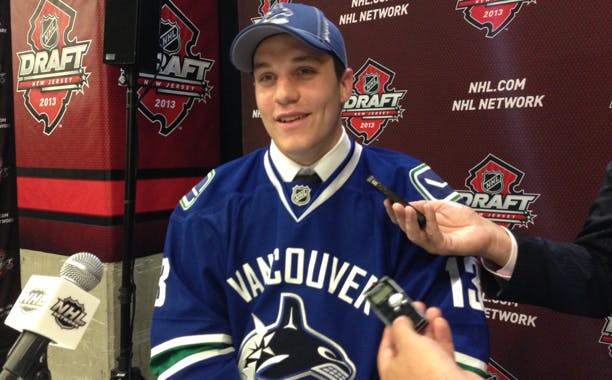2013 Canucks Draft Recap
The Canucks went into the 2013 NHL Draft needing to shed salary, bolster their bottom-six centre depth, add some heft to their prospect pipeline and address their goaltending log-jam. It was a tall order and the club managed to accomplish three of four, though they did so controversially and not in precisely the way most expected.
Regardless of whether or not Bo Horvat and Hunter Shinkaruk develop into stars, or whether the Canucks found serviceable NHL players in the likes of Cassels, Subban and Cederholm; Sunday, June 30th will be remembered as the day the Canucks waved the white flag on trading Roberto Luongo and moved the younger, more affordable Cory Schneider instead.
As much as the Canucks may claim, as Mike Gillis did after the conclusion of the first round, that "we didn’t feel there was a drop-off in either one’s play and felt (Luongo and Schneider) were both excellent, superb players," the fact is that Cory Schneider had usurped Luongo’s starters mantle over the past two seasons in Vancouver. Gillis admitted that the new collective bargaining agreement tied the clubs hands, while Laurence Gilman admitted that the team was dealing from a position of weakness leverage-wise. Both the Canucks General Manager and his Assistant seemed disappointed that the club didn’t manage to get a roster player, in addition to a top-pick, in their haul for Cory Schneider…
Read past the jump for more.
What’s particularly interesting about this Canucks draft is that, in terms of a pure talent haul, it looks at first blush like the best of the Mike Gillis era. That’s overshadowed of course by the Cory Schneider trade…
Bo Horvat was a bit of a reach at ninth overall, but he’s a skilled player who faced the toughest minutes among all London Knights centers and generated offense regardless. "He was a player that we have coveted from the outset of the year," Laurence Gilman said after the conclusion of the draft, "he’s the type of player that, y’know, we envision the Canucks being about. He’s a leader, he’s a future captain, he’s a big game player and we didn’t think there’d be any chance that a player of that caliber would be there at 24."
Those were sentiments echoed by Gillis earlier on Sunday when he described Horvat as "a 200-foot player," who compliments the pure offense that Hunter Shinkaruk brings to the table. "We got two complimentary players in the first round," said Gillis.
In Shinkaruk, Subban and Cederholm the Canucks took three players who were falling down the draft order due to the "risk" in their projections. For Shinkaruk it was his size and defensive play that caused him to fall to the end of round one, for Subban it was his size, and for Cederholm it was his perceived lack of offensive tools. On the topic of Shinkaruk, Gilman played down any concerns and raved about the young scorers tenacity "he’s an incredibly competitive kid, he’s very tenacious on the ice even though he’s not of big stature, but he never gives up," Gilman said, "that’s something our scouts just loved about him."
The other modest reach the Canucks made on Sunday was for Oshawa Generals centre Cole Cassels, who the team picked in the third round. Cassels faced some of the weakest competition among all Generals forwards a year ago, though his offensive production exploded in his sophmore major junior campaign as he was thrust into a top-six role on a juggernaut Generals club.
At the tail end of the draft the Canucks took a college bound overager in defenceman Mike Williamson, in addition to an inexperienced CHL defenceman in Miles Liberati. In all, the Canucks eschewed the overager heavy draft strategy they’ve gone to in recent years and selected six eighteen year olds and two CHL players after round four.
Asked about whether or not this draft was representative of a larger shift in the clubs overall amateur player procurement strategy, Gilman insisted it wasn’t. In his answer he dropped a curious nugget about the club drafting for positional need in past drafts:
"We’ve made some changes to the way that we’ve run our scouting staff. We’ve spent a great deal of time building our list in anticipation of this draft and we ran the draft for the most part based on the integrity of the list. In other years we have deviated, and in fairness to our scouts, we’ve deviated to draft for position. We were fortunate that the two picks that we got initially were very highly skilled centres which is something we’ve been looking for but we didn’t move to positional needs in this draft after we got the first two centres that we could draft whomever was available. And it just so happened that the players that we picked just so happened to be the highest guys on our list at the time of the selection."
Finally Gilman addressed what he called "a new era" for the clubs player development appartus, what with the addition of the Canucks owned AHL franchise (the Utica Comets). "Drafting is only one part, now we’ve got to develop them," Gilman said adding that "(player development and drafting) goes hand in hand."
It’ll be fascinating to watch how the Canucks handle the development of their 2013 draft class, and whether they err on the side of developmental caution or concede to the pressures of the salary cap era. "This is becoming a younger players league, more and more," Gilman explained "particularly teams at the top of the salary cap echelon like we are have a lot of pressure to place younger players on their roster because they’re more cost efficient."
Recent articles from Thomas Drance






